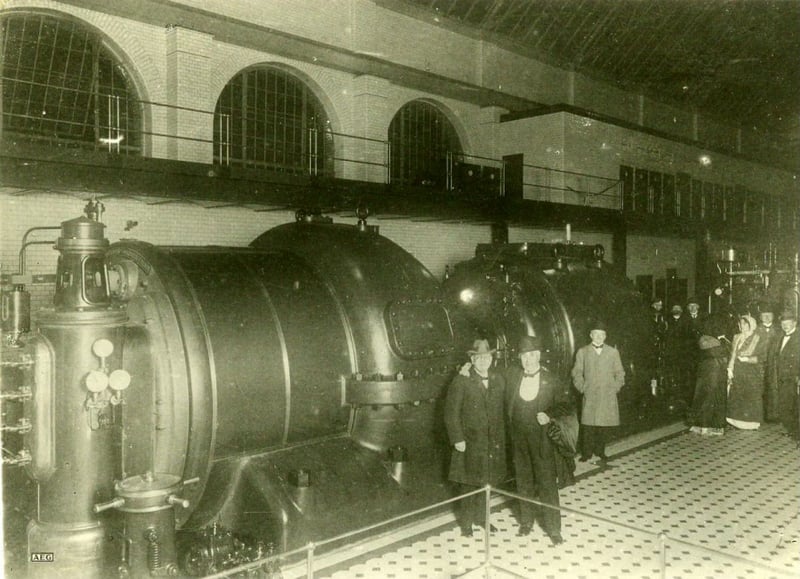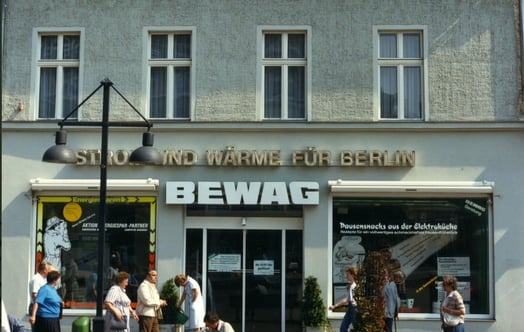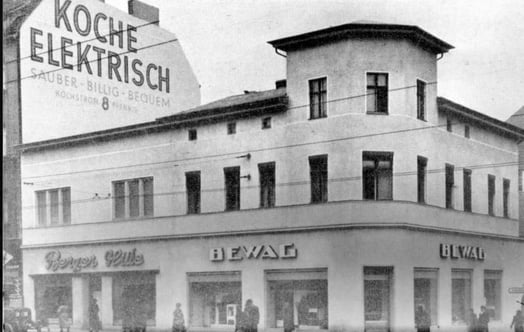Chronology Bewag (Berlin)
1884
Deutsche Edison-Gesellschaft uses 3 million German Marks to set up the public limited company 'Städtische Elektricitäts-Werke'. It is tasked with the commercial exploitation of electricity for lighting and power transmission in the current and future municipal area of the city of Berlin. This is the birth of the Berliner Elektricitätswerke (Bewag).
1885
On 15 August, the first public power plant in Germany starts operating at Markgrafenstrasse 44 with 540 kW.
1886
Rahtenau acquires shares in the Städtische Elektricitäts-Werke, saving it from the first crisis. Despite everything, capacity is expanded. In March, the second power plant starts operating in Mauerstrasse (285 kW).
1887
In November, the networks of the two power plants in Berlin were connected, creating the first grid. Deutsche Edison Gesellschaft becomes the Allgemeine Elektricitäts-Gesellschaft, AEG. It takes over the management of the Städtische Elektrizitäts-Werke, which are renamed 'Berliner Elektricitäts-Werke'.

Power plant Moabit 2 with Edison and Rathenau next to turbine 14 Year: 1911 | ID: VF000510
1923
Transformation of the company into a municipal public limited company under the name 'Berliner Städtische Elektrizitätswerke Aktiengesellschaft' (Bewag).
1931
Foundation of 'Berliner Kraft- und Licht-Aktiengesellschaft' (BKL) in order to acquire Städtische Elektrizitätswerke as a company.
1932
First flotation on the stock market of Berliner Kraft- und Licht-Aktiengesellschaft.
1948
Division of Bewag under the direction of the Soviet Central Kommandatura. Relocation of West Bewag to the Shellhaus in Tiergarten. Entry of Ost-Bewag (East Bewag) in the eastern commercial register.
1952
Division of the interconnected grid between East and West Berlin. West Berlin becomes an 'electricity island'.
1978/79
Transformation of Ost-Bewag into 'VEB Energieversorgung Berlin', later 'VEB Energiekombinat Berlin' (EKB). 1990 Founding of 'Energieversorgung Berlin AG' (EBAG) as the successor to EKB. Bewag takes over business activity.
1991
Acquisition of all shares in EBAG by Bewag.
1992
Launch of an 110 kV emergency connection between East and West Berlin. Recognition of Bewag’s restitution claims on EBAG by the Treuhandanstalt.
1994
Merger of EBAG with Bewag. End of isolated operation with a 380-kV interconnector to VEAG’s network.
1996
Integration of EVB into the parent company Bewag. Relocation of head office to Puschkinallee. Bewag supplies the whole of Berlin once again.
1997
Privatisation of Bewag through the sale of the Senate’s shares to Southern Energy (later Mirant) and later E.on AG.
1998
Renaming of 'Berliner Kraft- und Licht (Bewag)-Aktiengesellschaft' to 'Bewag Aktiengesellschaft'.
2001
Sale of the Bewag shares held by E.on to the Vattenfall subsidiary HEW. Setting up of “Neue Kraft” by Mirant, HEW and Vattenfall, with the participation of Bewag. Exit of Mirant and sale of Bewag shares to Vattenfall.
2002
Renaming of 'Neue Kraft' consisting of HEW, VEAG and Laubag to Vattenfall Europe AG. Start of the integration of Bewag into the Vattenfall Europe Group.
2003
Outsourcing of Bewag’s operations to Bewag Op. AG & Co. KG, merger of Bewag with Vattenfall Europe, entering of Bewag AG & Co. KG in the register of companies.
2004
Appointment of a joint Board for the companies Bewag and HEW, each with co-determination bodies.
2005
Bewag becomes Vattenfall Europe Berlin AG.
2007
Vattenfall loses approximately 250,000 customers in Berlin and Hamburg. It is due to a combination of an increased number of customer switching electricity provider, Vattenfall’s bruised reputation caused by broad media coverage of the rate increase announcement and the outages at the Krümmel and Brunsbüttel nuclear power plants. Vattenfall’s market share thus falls from roughly 85% in Berlin and 90% in Hamburg, to 79% and 83%, respectively.
2008
Vattenfall collaborates with BMW in an electric car project. Some 50 “Mini E” cars drive the streets of Berlin, where Vattenfall installs special charging posts at the test drivers’ homes.
2010
Vattenfall sells its subsidiary 50Hertz Transmission GmbH, which owns and operates Vattenfall’s German transmission grid, to the Belgian transmission system operator Elia and to the Australian Industry Funds Management (IFM).
2016
Vattenfall phases out coal in Berlin power plant.
2017
Vattenfall invests 325 MEUR into a new gas-fired combined heat and power plant in Berlin.



